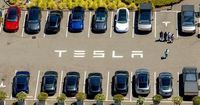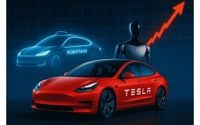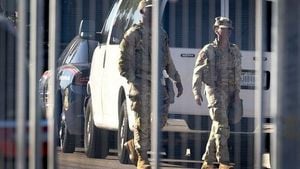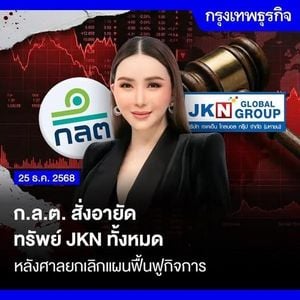Tesla’s third-quarter earnings report for 2025, released on October 22 and 23, painted a complex picture of a company at a crossroads. Despite posting record vehicle deliveries and surging revenue, the electric vehicle (EV) giant saw profit margins erode, triggering a drop in its share price and raising tough questions about its future direction as it pivots toward robotics and artificial intelligence.
According to Eurasia Business News, Tesla’s total revenue for the quarter soared 12% year-over-year to $28.1 billion, surpassing analyst expectations and supported by a record 497,099 vehicles delivered between July and September. This surge was largely driven by a rush of U.S. consumers eager to claim a $7,500 federal tax credit for EVs before it expired on September 30. Yet, beneath the surface, the company’s profit story was far less rosy.
Operating income tumbled 40% year-over-year to $1.6 billion, with non-GAAP earnings per share falling to $0.50—well below the $0.56 consensus forecast and a sharp drop from $0.72 a year prior. Reported net income came in at $1.4 billion, marking a 37% decline from the previous year, according to AP. This was the fourth straight quarter of profit decline for Tesla, a company that once seemed invincible in the EV space.
The reasons for the profit squeeze are multifaceted. As Invezz reported, Tesla’s aggressive push to introduce lower-cost Model 3 and Model Y variants, priced $5,000 to $5,500 less than prior models, along with temporary discounted lease rates on premium versions, put significant pressure on margins. These moves were designed to combat intensifying global competition and to appeal to a broader base of buyers, but they came at a cost. Additionally, the company’s income from regulatory credit trading—a once-reliable profit buffer—plunged 44% to $417 million after U.S. policy changes drastically reduced penalties for automakers missing emissions targets. Last year, Tesla had made $2.8 billion from credit trading, with three-quarters coming from the U.S. market.
It wasn’t just pricing and regulatory shifts squeezing Tesla’s bottom line. The company’s operating expenses skyrocketed 50% to $3.4 billion in the quarter, a surge driven by heavy investments in artificial intelligence, autonomous vehicles, and humanoid robots. CEO Elon Musk has repeatedly emphasized these areas as central to Tesla’s future, positioning the company not just as an automaker but as a leader in robotics and automation. According to AP, Musk told investors during the earnings call, “It’ll seem so real, that you’ll need to poke it,” referencing the company’s Optimus robots. He predicted this “robot army” could become “the biggest product of all time.”
Meanwhile, Tesla’s robotaxi business, which launched in Austin in June, continues to be a focal point. Musk expressed confidence that “safety monitors” could be removed from robotaxi vehicles in Austin by the end of the year, with plans to expand the service to as many as 10 other metro areas. The company also operates a rideshare service in the Bay Area, though it offered no firm timeline for fully autonomous operation.
Yet, even as Tesla attempts to diversify, its core EV business faces headwinds. Earlier in 2025, vehicle deliveries had plunged sharply due to a combination of demand challenges, political backlash—some of it stemming from Musk’s outspoken activism and alignment with right-wing politicians—and fierce competition from traditional automakers and new entrants alike. The introduction of stripped-down Model Y and Model X versions earlier in October, both priced just under $40,000, failed to impress investors who had hoped for a more dramatic price cut to reignite demand. “It’s a positive that they are increasingly diversifying from the auto business, but our primary concern is demand for EVs,” said Garrett Nelson, an analyst at CFRA Research, in comments to AP. “There’s a lot of uncertainty.”
Gross margin, a closely watched metric, settled at 18% for the quarter—the highest so far in 2025 but still down from 25% four years ago, reflecting the impact of discounts and incentives needed to fend off rivals. Tesla’s shares responded to the mixed news by slipping 2% to 3.5% in after-hours trading, as reported by AP and Mint. Free cash flow, however, was a bright spot, coming in at nearly $4 billion—well above analyst estimates and signaling that, for all its challenges, Tesla still has financial firepower to invest in its ambitious future.
The broader economic and political environment is also shaping Tesla’s outlook. The company cited uncertainties stemming from tariffs and fiscal policies under the Trump administration, which have added volatility to the market and made planning more difficult. In a statement, Tesla said, “While we face near-term uncertainty from shifting trade, tariff and fiscal policy, we are focused on long-term growth and value creation.”
Adding to the drama, CEO Elon Musk is facing scrutiny ahead of a pivotal November 6 shareholder vote on a $1 trillion compensation package. Proxy advisers ISS and Glass Lewis have urged shareholders to reject the proposal, citing concerns over its extraordinary scale and the need for safeguards to ensure Musk’s focus remains on Tesla, given his involvement in other ventures like SpaceX and xAI.
Musk, for his part, remains bullish on Tesla’s prospects. He has set ambitious targets for the robotaxi service, AI-driven products, and the Optimus robot line, all while promising to remove human safety monitors from autonomous vehicles in Austin by year-end. But questions linger about whether these bets will pay off quickly enough to offset slowing growth in the company’s core EV business.
Some on Wall Street remain optimistic. “It’s nice to have revenue come back,” said Brian Mulberry, a senior client portfolio manager at Zacks Investment Management, as quoted by AP. “There is still strong demand for Teslas.” Still, with Tesla’s profit margins under pressure, regulatory windfalls drying up, and political headwinds swirling, the company’s next moves will be closely watched by investors, competitors, and policymakers alike.
For now, Tesla stands as a company in transition—caught between the demands of today’s EV market and the promise of a high-tech, automated future. Whether it can deliver on both fronts remains the question that will define its next chapter.





